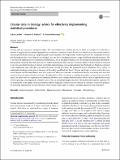Files in this item
Circular data in biology : advice for effectively implementing statistical procedures
Item metadata
| dc.contributor.author | Landler, Lukas | |
| dc.contributor.author | Ruxton, Graeme D. | |
| dc.contributor.author | Malkemper, E. Pascal | |
| dc.date.accessioned | 2018-07-26T11:30:08Z | |
| dc.date.available | 2018-07-26T11:30:08Z | |
| dc.date.issued | 2018-08 | |
| dc.identifier | 255069555 | |
| dc.identifier | d963561b-ebaa-402a-9e6c-0f5aadcd036d | |
| dc.identifier | 85049670330 | |
| dc.identifier | 000438316800002 | |
| dc.identifier.citation | Landler , L , Ruxton , G D & Malkemper , E P 2018 , ' Circular data in biology : advice for effectively implementing statistical procedures ' , Behavioral Ecology and Sociobiology , vol. 72 , no. 8 , 128 . https://doi.org/10.1007/s00265-018-2538-y | en |
| dc.identifier.issn | 0340-5443 | |
| dc.identifier.other | ORCID: /0000-0001-8943-6609/work/60427469 | |
| dc.identifier.uri | https://hdl.handle.net/10023/15712 | |
| dc.description | Open access funding provided by Research Institute of Molecular Pathology (IMP) / IMBA - Institute of Molecular Biotechnology / Gregor Mendel Institute of Molecular Plant Biology. | en |
| dc.description.abstract | Circular data are common in biological studies. The most fundamental question that can be asked of a sample of circular data is whether it suggests that the underlying population is uniformly distributed around the circle, or whether it is concentrated around at least one preferred direction (e.g. a migratory goal or activity phase). We compared the statistical power of five commonly used tests (the Rayleigh test, the V-test, Watson’s test, Kuiper’s test and Rao’s spacing test) across a range of different unimodal scenarios. The V-test showed higher power for symmetrical distributions, Rao’s spacing performed worst for all explored unimodal distributions tested and the remaining three tests showed very similar performance. However, the V-test only applies if the hypothesis is restricted to one (pre-specified) direction of interest. In all other unimodal cases, we recommend using the Rayleigh test. Much less explored is the multimodal case with data concentrated around several directions. We performed power simulations for a variety of multimodal situations, testing the performance of the widely used Rayleigh, Rao’s, Watson, and Kuiper’s tests as well as the more recent Bogdan and Hermans-Rasson tests. Our analyses of alternative statistical methods show that the commonly used tests lack statistical power in many of multimodal cases. Transformation of the raw data (e.g. doubling the angles) can overcome some of the issues, but only in the case of perfect f-fold symmetry. However, the Hermans-Rasson method, which is not yet implemented in any software package, outcompetes the alternative tests (often by substantial margins) in most of the multimodal situations explored. We recommend the wider uptake of the powerful but hitherto neglected Hermans-Rasson method. In summary, we provide guidance for biologists helping them to make decisions when testing circular data for single or multiple departures from uniformity. | |
| dc.format.extent | 10 | |
| dc.format.extent | 1555029 | |
| dc.language.iso | eng | |
| dc.relation.ispartof | Behavioral Ecology and Sociobiology | en |
| dc.subject | Animal navigation | en |
| dc.subject | Biostatistics | en |
| dc.subject | Chronobiology | en |
| dc.subject | Circadian | en |
| dc.subject | Emlen funnel | en |
| dc.subject | Magnetoreception | en |
| dc.subject | Ecology, Evolution, Behavior and Systematics | en |
| dc.subject | Animal Science and Zoology | en |
| dc.subject | DAS | en |
| dc.title | Circular data in biology : advice for effectively implementing statistical procedures | en |
| dc.type | Journal article | en |
| dc.contributor.institution | University of St Andrews. School of Biology | en |
| dc.contributor.institution | University of St Andrews. Centre for Biological Diversity | en |
| dc.identifier.doi | 10.1007/s00265-018-2538-y | |
| dc.description.status | Peer reviewed | en |
This item appears in the following Collection(s)
Items in the St Andrews Research Repository are protected by copyright, with all rights reserved, unless otherwise indicated.

